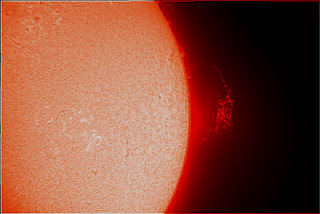If I can see solar prominences with the naked eye during a total eclipse, why do I need a hydrogen-alpha filter to see them at other times?

Ian / SkyandTelescope.com Photo Gallery
During a total eclipse the Moon completely blocks the Sun’s photosphere, or visible “surface,” allowing prominences (and the corona) to shine in all their glory. Without the Moon acting as a natural occulting disk, the photosphere is too dazzlingly radiant to see anything else.
But as you point out, anyone can see prominences any day with the aid of a telescope fitted with a hydrogen-alpha (Hα) filter. This special filter blocks all light from the Sun except for the red light emitted by excited hydrogen atoms at a wavelength of 656.3 nanometers (6563 angstroms). The hydrogen emission is responsible for the distinctive color of prominences and the chromosphere, the tenuous, hot layer of gas overlying the photosphere.
According to solar expert and eclipse veteran Jay Pasachoff (Williams College), the photosphere is approximately 1,000 times brighter than the chromosphere and 1 million times brighter than the corona. “Prominences have the same surface brightness as the chromosphere,” he says, “though less total brightness because they cover less area.” Prominences can also be viewed with an Hα coronagraph, a specialized refractor equipped with an Hα filter and an internal occulting disk that simulates a total eclipse.
— Edwin L. Aguirre
 0
0








Comments
You must be logged in to post a comment.